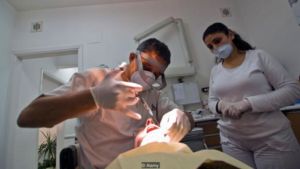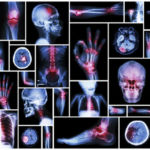By Chris Baraniuk
Some people are resistant to local anaesthetic, meaning they must endure dental and medical procedures without such pain relief. And we’re only beginning to understand why.

Dentists can attempt to use different kinds of drugs, or to inject the drug into a different part of the tissue, but these workarounds are not always successful (Credit: Alamy)
To Lori Lemon, the doctors all seemed flabbergasted. She had come in to the Mayo Clinic in Jacksonville, Florida, to have a lipoma – a growth of soft fatty tissue under the skin – removed from her elbow. She needed to have the area around the lump numbed for the procedure, but that was proving inexplicably difficult.
“All the ways and all the different medications that they had at their disposal – none of them worked,” she says. Steven Clendenen, an anaesthesiologist at the clinic, confirms her story. “The nerves were flooded with local anaesthetic and at the time it didn’t work,” he recalls. Her physicians might have been surprised, but Lemon wasn’t. She’d had this problem, local anaesthetic resistance, for as long as she could remember. The first time she remembers it coming up was decades ago at the dentists, when she was about seven.
“I just kind of screamed and was in tears the whole time – Lori Lemon”
“They started working on me and I, being obedient, I just raised my hand and let ’em know, ‘I can feel this’,” she says. Another injection of the local anaesthetic had no effect. “Finally I just kind of screamed and was in tears the whole time.”
Clendenen, who had seen first-hand the effects this resistance had on his patient, decided to investigate further. He found a handful of stories scattered in the medical literature concerning strange cases where patients claimed local anaesthetic had no effect on them. It turns out that no-one really knows what’s going on in these patients – either in terms of what mechanisms cause the resistance, or what the best remedy may be. But a new genetic study of Lemon and her family may set us on the path to discovering the answer.
Alan Hakim and his colleagues at University College Hospital in London were some of the first scientists to bring these cases to light. Hakim was helping to run a clinic for people with Ehlers-Danlos Syndrome (EDS), a group of very rare genetic diseases characterised by defects in connective tissue, leading to joint hypermobility, skin that bruises easily and fatigue.
But Hakim found that some of these patients reported resistance to local anaesthesia. Instead of going numb, they were having to endure the pain. “It became obvious to us that it was a question we should ask every patient we see in the clinic,” recalls Hakim, who co-authored a short report about the findings in 2005.
Eleven years after writing about the problem, Hakim says there has still been no formal medical investigation into the causes for local anaesthetic resistance in these cases, although there are a few theories. One hypothesis is that their tissue is slightly different from non-EDS patients and that might affect how the anaesthetic is absorbed. Local anaesthetics work by disrupting sodium channels. These channels conduct positively charged sodium ions – and with them the feeling of pain – to nerve cells. But there are still some questions over the nuts and bolts of this process. Filling in the details of that mechanism might explain why some patients find certain drugs – say, articaine instead of lidocaine – work better than others. One theory proposed for the heightened efficacy of articaine, for example, is that it is more soluble in fat (lipids) and therefore diffuses better through each nerve’s membrane.
It’s also possible that the patients’ nerves may be in slightly different places from the norm, with some evidence that dentists can overcome the problems by changing the location of the injection. Sometimes local anaesthetic is injected into the tissue under the skin, known as infiltration, and sometimes it is injected into or next to a nerve, what’s called a nerve block. In the latter case, the anaesthetic gets distributed directly to nerve cells further down the nervous system from the block. A dentist might use a nerve block if he or she is going to do a significant amount of drilling, for example, since more nerves will be affected and the anaesthetic will not have to diffuse through so much tissue to reach them.



I have Chiari, EDS, IIH, & all that comes with these disorders. I have 8 infected teeth left. I require surgery. Yet, dentists & oral surgeons are not educated at all about these debilitating disorders and the have to be. I acquired Chiari during jaw surgery in 2000. Why is these conditions not being taught? Especially to dentists and oral surgeons. So frustrating!
I feel so lucky that my dentist takes my EDS and chronic pain into account when treating me. I did send him a “Common Dental Issues with EDS” article once (like, literally, in the mail), but I don’t know if the anesthetic issue was on there. I don’t know if you just wanted to vent/share your experience, but if you’re looking for actionable steps, maybe send your dentist or oral surgeons that article a few weeks or months before you see them. If you want to be really assertive about it, make them read it at your appointment before they can treat you!
I am not venting. I just feel desperate due to the lack of dentists willing to take me on as a pt. They actually back up when I tell them I have chiari. Not contagious. I don’t have any dentist. My dentist of 3 decades retired. Should I make an appointment without telling them prior to seeing me & hand them articles? My biggest question is needing someone to hold my head & lower jaw very steady throughout the procedure. I also need to be laying down. Scared & alone
Oh, I’m sorry! It’s just amazing how terrible doctors (including dentists!) can act. One thing that’s helped me when I’m looking for a new doctor (I’ve not done this with a dentist, but the process would be similar) is to call the office and ask any questions I have about the provider I’m seeing. Do they know what EDS is? Do they know what Chiari is? Do they have experience treating patients with these conditions? Or whatever questions you think are important. It’s not weird, and they shouldn’t be rude about it. If there’s an email address for the office and you feel more comfortable emailing, do that. If they don’t have a dentist who is experienced with your conditions, can they recommend someone who might be? Some doctor’s offices offer a “meet-and-greet” first visit so you can ask questions and see if you’re a good match–why not do that with a dentist? You might not be able to, but maybe a quick phone call with the dentist or his/her assistant might provide you with more information. It’s not right that we, as patients, should be made to do this extra work. It’s time-consuming and can be disheartening. However, when you find the right provider who knows how to treat you, it’s well worth the time. I wish you a lot of luck in this endeavor!